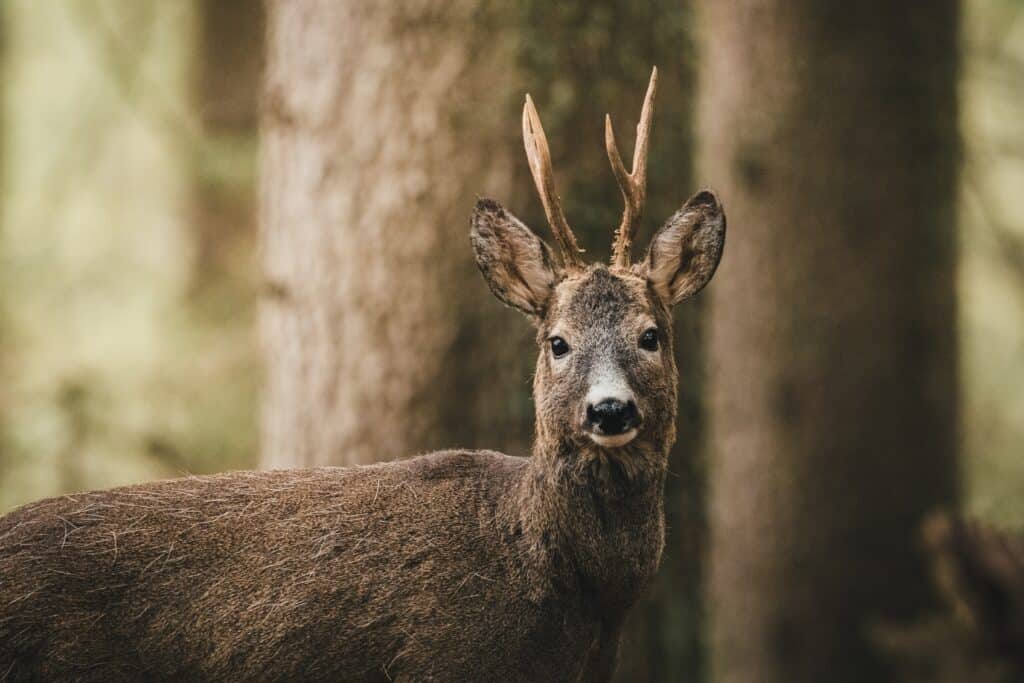Deer are one of the most commonly seen wildlife in the United States (if not the entire world, depending upon country population). These stunning herd animals make really beautiful subjects, with their slender legs and beautiful faces. However, capturing deer really does come down to being well versed in wildlife photography.
There are several difficulties that come with capturing deer. It does take specific cameras settings and techniques to properly frame these gorgeous animals in your viewfinder. But by adhering to these six secrets, you can really excel in your wildlife deer photography!
The Difficulty with Photographing Deer
As beautiful and serene as deer are, they can be a fairly complicated subject to capture.
For starters, deer are skittish and prone to avoiding people. This means that you’ll really have to travel out into nature to find them.
Secondly, once you’ve found the deer, you have to keep them there- by not scaring them!
Thirdly, as a wild animal, they may not be cooperative and give you the photograph you want. You need to adapt to their behavior and capture what they give you (and not be frustrated). It may be tempting to coax the deer with food, but this is a terrible idea! Outside of being dangerous, it’s unsafe for the deer to become too familiar with people as they will then become dependent upon humans to feed them (bad for the ecosystem).
Finally, it’s very important to be wary of hunters in your area to ensure an accident doesn’t happen. Make sure to keep in contact with rangers and be mindful during hunting season.
1. Telephoto Lenses Are Your Best Friend
Using lenses that capture far away subjects as if they are right next to you is a must have for capturing deer. As a wild animal, it isn’t safe (and even if it was, not recommended) to approach closely. This can spook the deer or disturb its natural behavior. As such, a telephoto lens is a popular addition to deer photographer bags!
Telephoto lenses are long focal length lenses that can remind you a bit of a telescope. These lenses can zoom you very close to your subject! Used most by animal and sport photographers, telephoto lenses allow you to sit far back and capture subjects as if you were right next to them.
Lenses like the 70-200mm F/2.8 telephoto zoom lens is a great purchase, or the 85mm F/1.4 telephoto lens is another great option. That being said, because you may not know where the deer will go, it is still suggested to lean on a lens that can change its focal length such as the 70-200 rather than the 85mm which is a fixed focal length. But, really, it’s up to you!
2. Silent Shooting Mode is Key
You never want your photography to interfere with what is happening. Set the camera to Silent Shooting Mode so that your shutter sounds aren’t scaring or distracting the deer. Nothing is a worse shame than waiting hours for a herd of deer only to have them scamper off from the sound of your camera.
Although most new DSLR cameras have a silent shooting mode, the truly silent cameras are the Mirrorless lines as these types of cameras have no physical shutter to click (sounds are artificial).
3. Use Continuous Focus to Lock On
Although many deer are very slow moving, serene, and calm as they graze, there may be instances in which deer gracefully leap off into the horizon. As such, you want to be ready for these special moments. You can do so by switching to Continuous Focus.
By default, your camera is set to One-Shot right out of the box. One-Shot achieves automatic focus on your subject for only one image, best used when capturing still life or product photography. Not the case here of course! In the camera menu, go to Autofocus Settings and switch it over to Continuous / AI / AI – C / AI Servo / C mode (depending on camera brand).
Continuous Focus is when the camera’s focus keeps refocusing on the subject as it moves. Even if your subject isn’t going anywhere, it doesn’t hurt to have continuous focus on at all times.
4. Burst Mode Activated!
Going hand in hand with continuous focus is burst mode. Every camera has something called FPS, or Frames-Per-Second. What this discloses is how many pictures a camera can snap per second of shooting.
Set your camera to Burst Mode or High Speed Continuous Shooting and for as long as your finger remains pressed down on the shutter, the camera will capture images as fast as its FPS dictates. This is excellent for sequences of action, from which you can select the best moment!
5. Choose Early Morning or Evening Hours
It’s a good idea to be well versed on the type of deer you are photographing, or how the deer behaves in the area you are shooting in.
For the most part, deer tend to be most active in the early morning or the early evening hours, though this can differ based upon area. Deer in more rural places will be active earlier than those in city areas (as they wait for there to be less people and activity outside).
6. Slow Movements Only
Deer are prey animals- and as such, all of their biology revolves around picking up the slightest disturbances in the area to alert them of predators. This means that any sudden movements can spook them and cause the entire herd to run! Be mindful of your movements and try to be slow and gentle.

